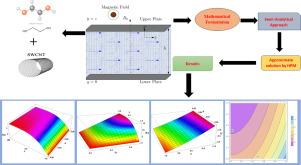Thermodynamic analysis on the SWCNT-EG-based nanofluid flow in a squeezing horizontal channel under the influence of thermal radiation and viscous dissipation
Q1 Mathematics
Partial Differential Equations in Applied Mathematics
Pub Date : 2025-06-01
DOI:10.1016/j.padiff.2025.101234
引用次数: 0
Abstract
The current study theoretically examines the behaviour of heat transfer in the ethylene glycol (EG)-based nanofluid containing single-walled carbon nanotubes (SWCNT) flow that is squeezed between a pair of horizontal parallel plates. Due to its superior thermal conductivity, EG-based SWCNT nanofluids are well-suited for use in high-performance cooling systems, including automotive radiators, electronic thermal management, industrial refrigeration, and heat exchangers across power generation, HVAC, and chemical processing applications. This study further focuses on analysing the thermal radiation effect on the thermodynamic properties of the viscous dissipated nanofluid flow. Employing suitable similarity transformations, the equations that govern flow and energy arising in the study are converted into a set of non-linear ordinary differential equations (ODEs), after which an approximate analytic solution is achieved using the homotopy perturbation method (HPM). This study mainly emphasizes on investigating the influence of distinct pertinent physical parameters on the velocity distribution curves, skin friction coefficient, temperature fields, and heat transfer rate. The HPM results are further compared with those of the classical finite difference method (FDM). It is evident from the current study that an elevation in the squeezing parameter and the Eckert number enhances the Nusselt number and temporal distribution curve. However, an elevation in the radiation parameter decreases the Nusselt number.

基于swcnts - egg的纳米流体在热辐射和粘性耗散影响下在挤压水平通道中流动的热力学分析
目前的研究从理论上考察了乙二醇(EG)基纳米流体中的传热行为,其中包含单壁碳纳米管(SWCNT)流动,该流动被挤压在一对水平平行板之间。由于其优越的导热性,基于egg的SWCNT纳米流体非常适合用于高性能冷却系统,包括汽车散热器,电子热管理,工业制冷,以及发电,暖通空调和化学处理应用中的热交换器。本研究进一步着重分析了热辐射对粘性耗散纳米流体流动热力学性质的影响。采用适当的相似变换,将研究中产生的控制流量和能量的方程转化为一组非线性常微分方程,然后利用同伦摄动法(HPM)得到近似解析解。本研究重点研究了不同的相关物理参数对速度分布曲线、表面摩擦系数、温度场和换热率的影响。并与经典有限差分法(FDM)的结果进行了比较。从目前的研究中可以明显看出,挤压参数和Eckert数的升高会增强努塞尔数和时间分布曲线。然而,辐射参数的升高会降低努塞尔数。
本文章由计算机程序翻译,如有差异,请以英文原文为准。
求助全文
约1分钟内获得全文
求助全文
来源期刊

Partial Differential Equations in Applied Mathematics
Mathematics-Analysis
CiteScore
6.20
自引率
0.00%
发文量
138
审稿时长
14 weeks
 求助内容:
求助内容: 应助结果提醒方式:
应助结果提醒方式:


